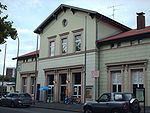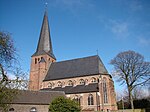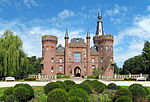Duchy of Cleves

The Duchy of Cleves (German: Herzogtum Kleve; Dutch: Hertogdom Kleef) was a State of the Holy Roman Empire which emerged from the medieval Hettergau. It was situated in the northern Rhineland on both sides of the Lower Rhine, around its capital Cleves and the towns of Wesel, Kalkar, Xanten, Emmerich, Rees and Duisburg bordering the lands of the Prince-Bishopric of Münster in the east and the Duchy of Brabant in the west. Its history is closely related to that of its southern neighbours: the Duchies of Jülich and Berg, as well as Guelders and the Westphalian county of Mark. The Duchy was archaically known as Cleveland in English. The duchy's territory roughly covered the present-day German districts of Cleves (northern part), Wesel and the city of Duisburg, as well as adjacent parts of the Limburg, North Brabant and Gelderland provinces in the Netherlands.
Excerpt from the Wikipedia article Duchy of Cleves (License: CC BY-SA 3.0, Authors, Images).Duchy of Cleves
Kolpingstraße, Cleves Unterstadt
Geographical coordinates (GPS) Address Phone number Website Nearby Places Show on map
Geographical coordinates (GPS)
| Latitude | Longitude |
|---|---|
| N 51.783333333333 ° | E 6.1333333333333 ° |
Address
Evangelische Stiftung Kleve
Kolpingstraße
47533 Cleves, Unterstadt
North Rhine-Westphalia, Germany
Open on Google Maps






